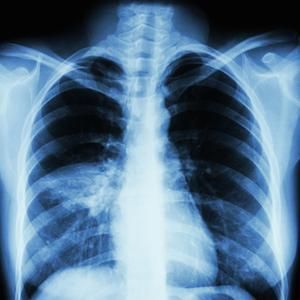[1]
Semenkovich TR, Frederiksen C, Hudson JL, Subramanian M, Kollef MH, Patterson GA, Kreisel D, Meyers BF, Kozower BD, Puri V. Postoperative Pneumonia Prevention in Pulmonary Resections: A Feasibility Pilot Study. The Annals of thoracic surgery. 2019 Jan:107(1):262-270. doi: 10.1016/j.athoracsur.2018.08.008. Epub 2018 Oct 3
[PubMed PMID: 30291834]
Level 2 (mid-level) evidence
[2]
Silva ARAD, Silva TCD, Bom GJT, Vasconcelos RMB, Junior RS. Ventilator-associated pneumonia agents in Brazilian Neonatal Intensive Care Units - a systematic review. The Brazilian journal of infectious diseases : an official publication of the Brazilian Society of Infectious Diseases. 2018 Jul-Aug:22(4):338-344. doi: 10.1016/j.bjid.2018.06.002. Epub 2018 Jul 5
[PubMed PMID: 30278872]
Level 1 (high-level) evidence
[3]
Antcliffe DB, Wolfer AM, O'Dea KP, Takata M, Holmes E, Gordon AC. Profiling inflammatory markers in patients with pneumonia on intensive care. Scientific reports. 2018 Oct 3:8(1):14736. doi: 10.1038/s41598-018-32938-6. Epub 2018 Oct 3
[PubMed PMID: 30283005]
[5]
Iosifidis E, Pitsava G, Roilides E. Ventilator-associated pneumonia in neonates and children: a systematic analysis of diagnostic methods and prevention. Future microbiology. 2018 Sep:13():1431-1446. doi: 10.2217/fmb-2018-0108. Epub 2018 Sep 26
[PubMed PMID: 30256161]
Level 1 (high-level) evidence
[6]
Watson K, Heales LJ, Fernando J, Reoch J, Tan E, Smith K, Austin D, Divanoglou A. Incidence and characteristics of ventilator-associated pneumonia in a regional non-tertiary Australian intensive care unit: protocol for a retrospective clinical audit study. BMJ open. 2018 Sep 8:8(9):e021733. doi: 10.1136/bmjopen-2018-021733. Epub 2018 Sep 8
[PubMed PMID: 30196266]
Level 2 (mid-level) evidence
[7]
Ferrer M, Torres A. Epidemiology of ICU-acquired pneumonia. Current opinion in critical care. 2018 Oct:24(5):325-331. doi: 10.1097/MCC.0000000000000536. Epub
[PubMed PMID: 30080701]
Level 3 (low-level) evidence
[8]
Phillips-Houlbracq M, Ricard JD, Foucrier A, Yoder-Himes D, Gaudry S, Bex J, Messika J, Margetis D, Chatel J, Dobrindt U, Denamur E, Roux D. Pathophysiology of Escherichia coli pneumonia: Respective contribution of pathogenicity islands to virulence. International journal of medical microbiology : IJMM. 2018 Mar:308(2):290-296. doi: 10.1016/j.ijmm.2018.01.003. Epub 2018 Jan 5
[PubMed PMID: 29325882]
[9]
Grief SN, Loza JK. Guidelines for the Evaluation and Treatment of Pneumonia. Primary care. 2018 Sep:45(3):485-503. doi: 10.1016/j.pop.2018.04.001. Epub
[PubMed PMID: 30115336]
[10]
Dianti M, Luna CM. Do we need biomarkers for the follow-up and shortening of antibiotic treatment duration? Current opinion in critical care. 2018 Oct:24(5):361-369. doi: 10.1097/MCC.0000000000000540. Epub
[PubMed PMID: 30124483]
Level 3 (low-level) evidence
[11]
Ambaras Khan R, Aziz Z. The methodological quality of guidelines for hospital-acquired pneumonia and ventilator-associated pneumonia: A systematic review. Journal of clinical pharmacy and therapeutics. 2018 Aug:43(4):450-459. doi: 10.1111/jcpt.12696. Epub 2018 May 2
[PubMed PMID: 29722052]
Level 2 (mid-level) evidence
[12]
Chomton M, Brossier D, Sauthier M, Vallières E, Dubois J, Emeriaud G, Jouvet P. Ventilator-Associated Pneumonia and Events in Pediatric Intensive Care: A Single Center Study. Pediatric critical care medicine : a journal of the Society of Critical Care Medicine and the World Federation of Pediatric Intensive and Critical Care Societies. 2018 Dec:19(12):1106-1113. doi: 10.1097/PCC.0000000000001720. Epub
[PubMed PMID: 30234676]
[13]
Martin-Loeches I, Rodriguez AH, Torres A. New guidelines for hospital-acquired pneumonia/ventilator-associated pneumonia: USA vs. Europe. Current opinion in critical care. 2018 Oct:24(5):347-352. doi: 10.1097/MCC.0000000000000535. Epub
[PubMed PMID: 30063491]
Level 3 (low-level) evidence
[14]
Niederman MS. Antibiotic treatment of hospital-acquired pneumonia: is it different from ventilator-associated pneumonia? Current opinion in critical care. 2018 Oct:24(5):353-360. doi: 10.1097/MCC.0000000000000531. Epub
[PubMed PMID: 30028739]
Level 3 (low-level) evidence
[15]
Jam R, Mesquida J, Hernández Ó, Sandalinas I, Turégano C, Carrillo E, Pedragosa R, Valls J, Parera A, Ateca B, Salamero M, Jane R, Oliva JC, Delgado-Hito P. Nursing workload and compliance with non-pharmacological measures to prevent ventilator-associated pneumonia: a multicentre study. Nursing in critical care. 2018 Nov:23(6):291-298. doi: 10.1111/nicc.12380. Epub 2018 Sep 5
[PubMed PMID: 30182383]
[16]
Munro S, Haile-Mariam A, Greenwell C, Demirci S, Farooqi O, Vasudeva S. Implementation and Dissemination of a Department of Veterans Affairs Oral Care Initiative to Prevent Hospital-Acquired Pneumonia Among Nonventilated Patients. Nursing administration quarterly. 2018 Oct/Dec:42(4):363-372. doi: 10.1097/NAQ.0000000000000308. Epub
[PubMed PMID: 30180083]
Level 2 (mid-level) evidence
[17]
Chen Z, Shi X. Adverse events of high-dose tigecycline in the treatment of ventilator-associated pneumonia due to multidrug-resistant pathogens. Medicine. 2018 Sep:97(38):e12467. doi: 10.1097/MD.0000000000012467. Epub
[PubMed PMID: 30235740]
[18]
Pozuelo-Carrascosa DP, Torres-Costoso A, Alvarez-Bueno C, Cavero-Redondo I, López Muñoz P, Martínez-Vizcaíno V. Multimodality respiratory physiotherapy reduces mortality but may not prevent ventilator-associated pneumonia or reduce length of stay in the intensive care unit: a systematic review. Journal of physiotherapy. 2018 Oct:64(4):222-228. doi: 10.1016/j.jphys.2018.08.005. Epub 2018 Sep 13
[PubMed PMID: 30220625]
Level 1 (high-level) evidence

